The preparation for your case interview in management consulting requires a lot of work, diligence, perseverance, and discipline. It is not uncommon for many candidates to focus on the case interview itself, without keeping the CV questions in mind. Even if it makes up the smaller part of the interview, it is still equally important in the interviewer's decision as to your case-solving. Within this article, our case interview coach Clara gives you insights into how to answer intro as well as CV questions. You will find several detailed examples including practical hints and solutions.


Introductional and CV Questions – How You Should Prepare and Respond
In consulting interviews, candidates will usually face two or three on-site rounds of interviews with consultants. This series of 3 expert articles, focused on the preparation of the FIT part, will provide guidance to prepare the initial part of those in-person interviews –of which, normally, the initial 15` will be dedicated to FIT-. Everything you need to know about motivational interview questions and behavioral interview questions is included in my other two articles.
Although many candidates underestimate FIT and focus their preparation on business cases, FIT is as important to be prepared as business cases. In consulting interviews, FIT is an in-depth assessment of your skillset, not a standard motivational interview.
The importance of the FIT interview derives from the job description and required skillset of a consultant, not limited to analytical and problem-solving skills, but also encompassing team and client management abilities. These last two cannot be tested through business cases, hence the importance of FIT.
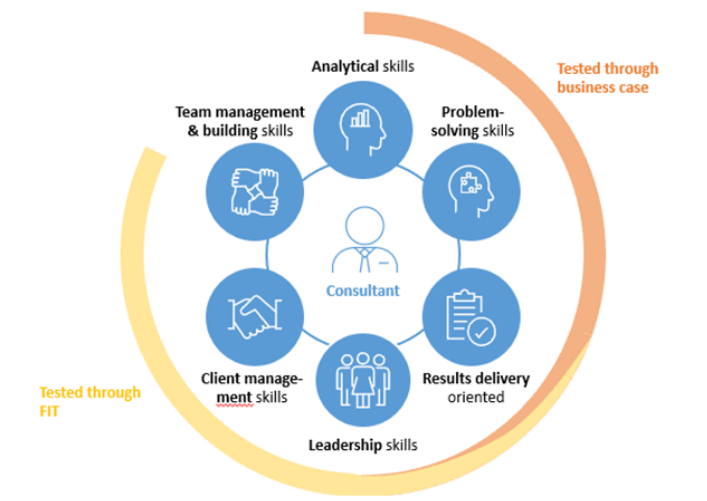
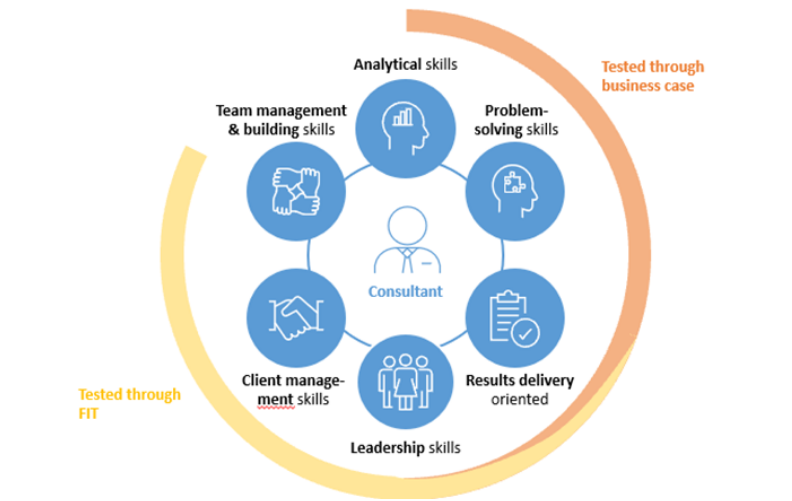
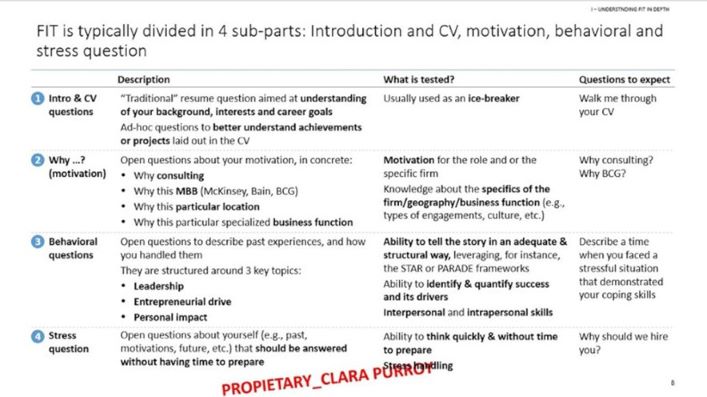
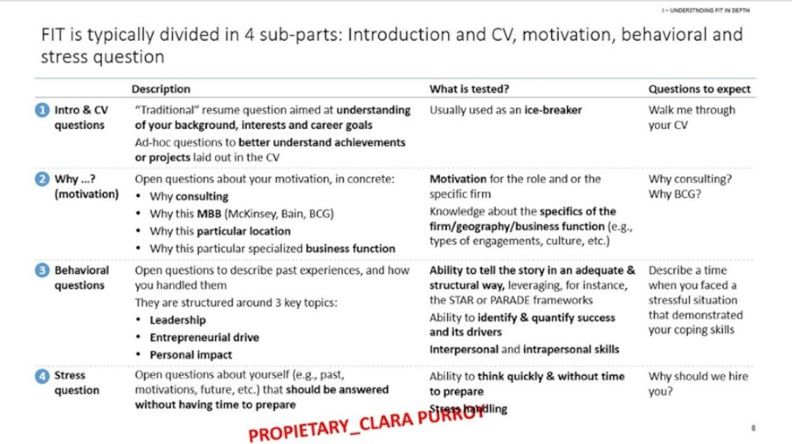
Intro and CV questions are the “traditional” resume question aimed at gaining an understanding of your:
- Background: studies, past working experiences, etc.
- Interests: usually stated in the last part of your CV, but not limited to those
- Career goals: on top of the past experience, “connect the dots” about where those experiences are leading you long term
They also encompass ad-hoc questions to better understand achievements or projects laid out in the CV.
2.1 What Are the Interviewer's Goals With These Questions?
- Getting to know the candidate at a personal level
- Assessing whether the candidate has certain qualities and soft skills that are key for consulting
- Determining whether the candidate shares the company’s values
- Although usually used as an ice-breaker by McKinsey and BCG, Bain's interview can greatly incise in CV questions, sometimes even substituting behavioral questions (i.e., stories around leadership, personal impact, and entrepreneurial drive)
2.2 Which Communications Techniques Can Be Leveraged?
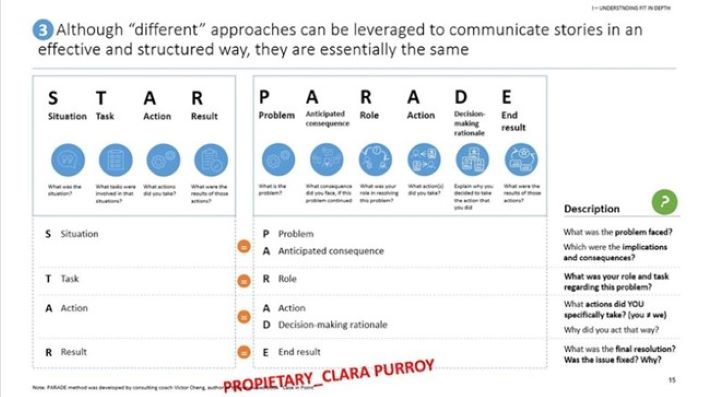
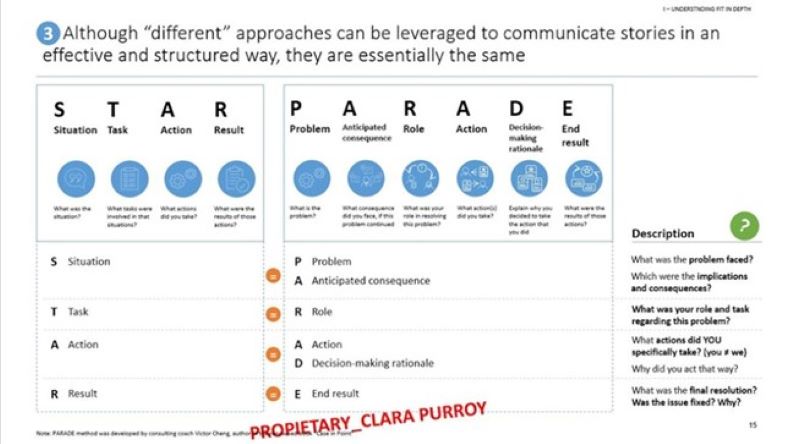
STAR or PARADE methodologies are “different” approaches/techniques that can be leveraged to communicate stories in an effective and structured way.
STAR stands for:
Situation→ Task → Action → Result.
PARADE is similar to that just enhanced and modified with further aspects to have a look at:
Problem → Anticipated Consequence → Role → Action → Decision-Making Rationale → End Result
By using these communications techniques, you are able to structure your answer efficiently without wasting your time jumping from one thought to another. When using the STAR/PARADE methodology, you answer your interviewer’s question by starting with the problem you faced as well as with the implications and consequences that followed along. After that, you describe your role and task regarding this problem. Most importantly, you will then describe the specific actions you took to solve the problem. Finally, in the last part of your answer, following those methodologies, you will come to the final resolution and should tell the interviewer if the problem at hand has been fixed or not, of course, accompanied by an explanation.
➥ Graphs from the Integrated FIT Guide for MBB
2.3 General Tips When Answering Intro and CV Questions:
- Be structured, following the STAR/PARADE methodology: Start with the problem and its consequences. This is followed by your role and the actions you personally took to solve the issue and lastly the result of your actions and if it has led to the desired outcome.
- Enrich the story with multiple data points, there are never too many!
- Numerical KPIs: Try to quantify your impact with relevant data points as this will lead to a more valuable and tangible answer and your interviewer will be able to better follow your example.
- Non-numerical: Non-numerical data points are equally important to understand the story and the impacts achieved.
Detailed Example 1: Walk Me Through Your CV
Hints
Although there isn´t a “one and only” right way to walk the interviewer through your CV, the following guidelines will help you deliver your answer and your trajectory in a clear and impactful manner:
- Be structured, following when possible a temporal structure:
- Opt 1: Starting from most recent events: when your last experience is particularly relevant – normally applies to experienced hires.
- Opt 2: Starting from your education and following a chronological order: when it helps to understand your trajectory and decisions – normally applies to junior profiles with not-so-relevant working experience.
- Be consistent: don't mention points that are not included in the CV (e.g., long-term career goals, etc.)
Short Example
Graduate: I recently graduated from Imperial College, where I obtained my master's in Management Engineering, finishing in the top 3% of the class. Last summer I did an internshipStrategy Consulting.
Experienced hire: After starting my career in Public Sector, I transitioned to a Fortune500 Company 5 years ago, looking for a more hands-on approach and clear scope. In my last role, I grew tremendously personally and professionally, and I realized I am passionate about people management: both with younger peers and clients. Hence, I would like to transition to Consulting to keep growing in this area, as well as achieve a higher impact on meaningful projects.
Detailed Example 2: Tell Me About Yourself
Hints
- Differently from a CV overview, you don't need to mention all sections in it or do it in a time-sequence order
- By mentioning only determined milestones in the CV, you tell the interviewer what defines you, not what you have done so far
- Mention also what drives you and makes you passionate: this is the question to enrich the “facts” that are described in your CV
- If you could research your interviewer before (normally only possible in Bain) and you have points in common, try to emphasize them by bringing them up (if relevant)
Example
I have always been passionate about Strategy. Even during High School, I spent my summers helping my mother with our family business, and SME focused on retail. Over time, it's been clear to me that the part that excites me most about our SME and business, in general, was not procurement or product, but Strategy. I am passionate about analyzing, planning, and actioning plans for growth and improvement. Hence, joining Strategy Consulting has been my career goal for years, since I want to keep learning how to help companies.
Detailed Example 3: Tell Me About the Thing That Makes You Most Proud on Your CV
Hints
- Be detailed: don't choose a period of your life but something specific that happened in it (e.g., a particular project instead of a two-year job)
- Be prepared to present it as you would present a story included in the behavioral questions, leveraging the STAR or PARADE framework (although shorter, 1-2 mins instead of 10-12 mins)
Example
What makes me most proud is funding the Consulting Club at my university. Since it's not one of the “target” universities for MBB, people were feeling discouraged to apply, and those who applied felt they didn't have the resources or a support group. Hence, 2 years ago I founded the cited Club, aimed at encouraging potential candidates and helping those in the process. It has been a huge success (we had 50 members in the 1st year and 150 in the 2nd year), and 10 people got offers after year 1 (while the previous year, only 1 at this Uni did). It has been very fulfilling since it has truly helped people, as well as being a great personal project for me, teaching me how to set up something from the beginning and make it scale.
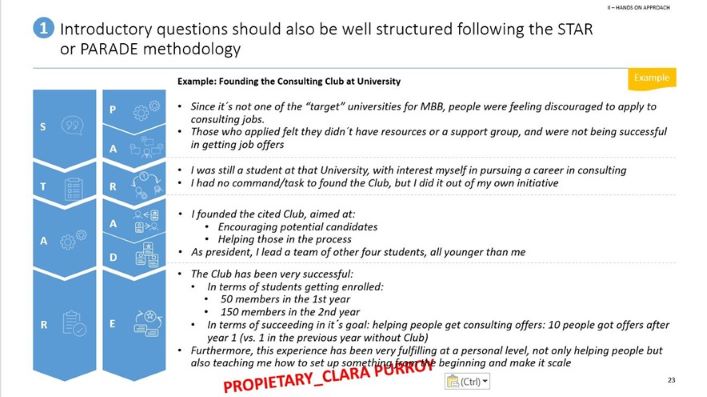
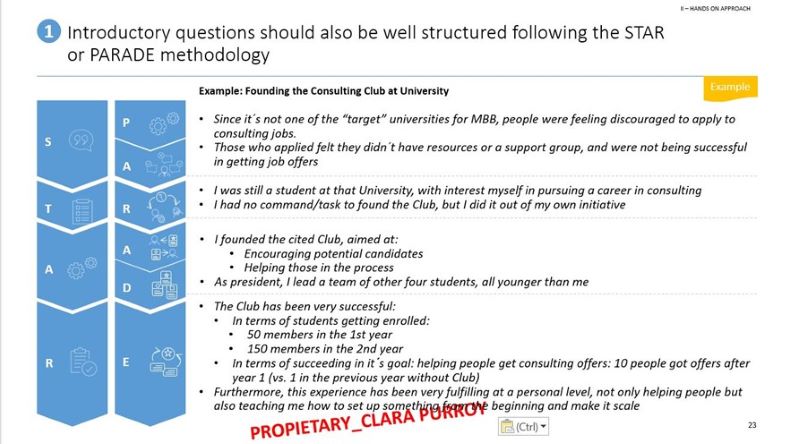
➥ Graphs from the Integrated FIT Guide for MBB
If you liked this article, you can find two more from the same FIT preparation series:
Your next step will be to take the theoretical knowledge you have gained and put it into action! On PrepLounge, you can practice interviews with other case partners who cannot only test your case-solving skills but also your performance in answering behavioral interview questions. Thus, make sure you propose a practice session on our Meeting Board to receive helpful feedback on your stories. Further, you can make use of our interactive Stress Question tool. Here you can go through more than 110 possible questions that could come up during the personal fit part of your interview.
Finally, we would like to recommend Clara’s Integrated FIT Guide to you. It provides an end-to-end preparation for all three MBB interviews, as well as other consulting interviews, combining key concepts review and a hands-on methodology. Following the guide, you will prepare your stories by practicing with over 50 real questions and leveraging special frameworks and worksheets that guide you step-by-step. Finally, as further guidance, the guide encompasses over 20 examples from real candidates.
About the Author
McKinsey | Awarded professor at Master in Management @ IE | MBA at MIT |+180 students coached | Integrated FIT Guide author
- Professional Experience: Instituto de Empresa Business School, Amazon, McKinsey & Company
- Languages: English, French, Italian, Spanish
- Location: Spain
Clara started her career at McKinsey & Company, where she focused on Telco, Oil & Gas, and Real Estate. She later joined the team that launched Amazon Business in Spain, where she is nowadays in charge of several capability-building and coaching programs for the Spanish Marketplace department.
Clara teaches “Data Insights and Visualization” in the Master in Management at Instituto de Empresa in Madrid, where she has received the Teaching Excellence Award, as the best-valued course by the students. She has also coached 180+ candidates on diverse platforms, such as PrepLounge. Furthermore, she is the founder and president of the NGO Building their Future since 2015, focused on educational projects in Nairobi, Kenya.
Continue to Learn







